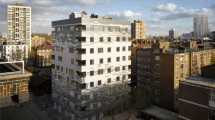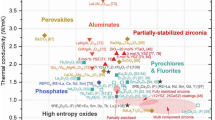Abstract
This work explores the potentialities of combining a multi-layer eco-friendly panel with a phase change material coating. Although the work is based on a numerical approach performed by COMSOL Multiphysics® computer program, it can be considered as rigorous, robust, and optimized since the most important parameters added to the model were experimentally evaluated. The scientific soundness was guaranteed by a comparative analysis performed in two different times. The cork-coconut-cork panel was firstly investigated as it was, and secondly it was analysed with a phase change material layer applied on. In the second step, the panel undergone a mechanical process concerning the realization of a subsurface defect simulating a detachment. The aim was based on the conduction of a thermal conductivity analysis to characterize the benefits deriving from the application of the coating, as well as the negative effects introduced by the subsurface defect resembling a potential thermal bridge. The experiments were performed in Italy in a place identified into the manuscript (see "Testing procedure" section) by means of geographical coordinates.























Similar content being viewed by others
References
Zalba B, Marìn J, Cabeza LF, Mehling H. Review on thermal energy storage with phase change: materials, heat transfer analysis and applications. Appl Therm Eng. 2003;23:251–83.
Lamberg P, Lehtiniemi R, Henell A-H. Numerical and experimental investigation of melting and freezing processes in phase change material storage. Int J Therm Sci. 2004;43:277–87.
Hawladera MNA, Uddin MS, Khin MM. Microencapsulated PCM thermal-energy storage system. Appl Energy. 2003;74:195–202.
Schossig P, Henning HM, Gschwander S, Haussmann T. Micro-encapsulated phase-change materials integrated into construction materials. Sol Energy Mater Sol Cells. 2005;89:297–306.
Mesalhy O, Lafdi K, Elgafy A, Bowman K. Numerical study for enhancing the thermal conductivity of phase change material (PCM) storage using high thermal conductivity porous matrix. Energy Convers Manag. 2005;46:847–67.
Nayak KC, Saha SK, Srinivasan K, Dutta P. A numerical model for heat sinks with phase change materials and thermal conductivity enhancers. Int J Heat Mass Transf. 2006;49:1833–44.
Zhang D, Tian S, Xiao D. Experimental study on the phase change behavior of phase change material confined in pores. Sol Energy. 2007;81:653–60.
Tan FL, Hosseinizadeh SF, Khodadadi JM, Fan L. Experimental and computational study of constrained melting of phase change materials (PCM) inside a spherical capsule. Int J Heat Mass Transf. 2009;52:3464–72.
Nomura T, Okinaka N, Akiyama T. Impregnation of porous material with phase change material for thermal energy storage. Mater Chem Phys. 2009;115:846–50.
Tyagia VV, Kaushik SC, Tyagi SK, Akiyama T. Development of phase change materials based microencapsulated technology for buildings: a review. Renew Sustain Energy Rev. 2011;15:1373–91.
Zhou D, Zhao CY. Experimental investigations on heat transfer in phase change materials (PCMs) embedded in porous materials. Appl Therm Eng. 2011;31:970–7.
Dutil Y, Rousse DR, Salah NB, Lassue S, Zalewski L. A review on phase-change materials: mathematical modeling and simulations. Renew Sustain Energy Rev. 2011;15:112–30.
Kuznik F, David D, Johannes K, Roux J-J. A review on phase change materials integrated in building walls. Renew Sustain Energy Rev. 2011;15:379–91.
Jelle BP. Traditional, state-of-the-art and future thermal building insulation materials and solutions: properties, requirements and possibilities. Energy Build. 2011;43:2549–63.
Pacheco-Torgal F. Eco-efficient construction and building materials research under the EU Framework Programme Horizon 2020. Constr Build Mater. 2014;51:151–62.
Perilli S, Sfarra S, Guerrini M, Bisegna F, Ambrosini D. The thermophysical behaviour of cork supports doped with an innovative thermal insulation and protective coating: a numerical analysis based on in situ experimental data. Energy Build. 2018;159:508–28.
Technical Association of Pulp and Paper Industry. TAPPI standard test method: fibrous materials and pulp testing T 1-200 series. New York: TAPPI; 1998.
Mari EL. Binderless board from coconut (Cocos nucifera L.) coir dust. For Prod Res Dev Inst J (FPRDIJ). 1996;22(1):45–54.
Panyakaew S, Fotios S. New thermal insulation boards made from coconut husk and bagasse. Energy Build. 2011;43(7):1732–9.
Şen A, Miranda L, Santos S, Graça J, Pereira H. The chemical composition of cork and phloem in the rhytidome of Quercus cerris bark. Ind Crops Prod. 2010;31(2):417–22.
Chuen KW, Qian CW, Hwa CC, Fouladi MH. Effect of using coconut fibre and polypropylene for thermal insulation in a flat plate collector. J Eng Sci Technol. 2015;10:41–9.
https://www.tecnosugheri.it/wp/wp-content/uploads/2015/10/Scheda-tecnica-cocco.pdf. Accessed 26 May 2017.
https://www.tecnosugheri.it/wp/wp-content/uploads/2015/10/Scheda_Corkpan.pdf. Accessed 26 May 2017.
https://www.engineeringtoolbox.com. Accessed 27 May 2017.
https://www.tecnosugheri.it/Scheda-tecnica-cocco.pdf. Accessed 27 May 2017.
Barreira E, Bauer E, Mustelier N, Freitas VP. Measurement of materials emissivity: influence of the procedure. In: Proceddings of AITA—13th international workshop on advanced infrared technology and applications, 2015. p. 242–45.
Ordovás J, Carmona E, Moreno MT, Ortega MC. Characteristics of internal porosity of cork container media. HortScience. 1996;31:1177–9.
Rodríguez NJ, Yáňez-Limón M, Gutiérrez-Miceli FA, Gomez-Guzman O, Matadamas-Ortiz TP, Lagunez-Rivera L, Vazquez-Feijoo JA. Assessment of coconut fibre insulation characteristics and its use to modulate temperatures in concrete slabs with the aid of a finite element methodology. Energy Build. 2011;43:1264–72.
Sung WP, Kao JCM, Chen R. Environment, energy and sustainable development, vol. 1. Boca Raton: CRC Press; 2013.
Chwieduk DA. Dynamics of external wall structures with a PCM (phase change materials) in high latitude countries. Energy. 2013;59:301–13.
http://www.concretecentre.com/eurocode2. Accessed 20 April 2017.
Azenha M, Faria R, Figueiras H. Thermography as a technique for monitoring early age temperatures of hardening concrete. Constr Build Mater. 2011;25(11):4232–40.
Guo CX, Ma XL, Yang L. PCM/graphite foam composite for thermal energy storage device. In: Global conference on polymer and composite materials. IOP conference series: materials science and engineering, vol. 87; 2015. p. 1–11.
Cabeza LF, Castell A, Barreneche C, de Gracia A, Fernández AI. Materials used as PCM in thermal energy storage in buildings: a review. Renew Sustain Energy Rev. 2011;15(3):1675–95.
http://www.chemicalbook.com/ChemicalProductProperty_US_CB9853920.aspx. Accessed 20 April 2017.
Vargaftik NB, Filippov LP, Tarzimanov AA, Totskii EE. Handbook of thermal conductivity of liquids and gases. Boca Raton: CRC Press; 1993.
Sarı A, Alkan C, Karaipekli A, Önal A. Preparation, characterization and thermal properties of styrene maleic anhydride copolymer (SMA)/fatty acid composites as form stable phase change materials. Energy Convers Manag. 2008;49(2):373–80.
Kolesnikov SI, Syunyaev ZI. Phase transitions in the melting and crystallization of n-C18H38 and n-C20H42. Zhur Prikl Khim (Leningr). 1985;58(10):2267–71.
Green DW, Perry RH, Liley PE, Thomson GH, Friend DG, Daubert TE, Buck E. Perry’s chemical engineers’ handbook, section 2: physical and chemical data. 8th ed. New York: Mc Graw Hill Education; 2007.
Yu S, Wang X, Wu D. Microencapsulation of n-octadecane phase change material with calcium carbonate shell for enhancement of thermal conductivity and serving durability: synthesis, microstructure, and performance evaluation. Appl Energy. 2014;114:632–43.
Hoehne GWH. Transitions of n-alkanes above the melting point. Polym Bull. 1981;6:41–6.
Messerly JF, Guthrie GB, Todd SS, Finke HL. Low-temperature thermal data for n-pentane, n-heptadecane and n-octadecane. Revised thermodynamic functions for the n-alkanes, C5-C18. J Chem Eng Data. 1967;12(3):338–46.
Principi P, Fioretti R. Thermal analysis of the application of pcm and low emissivity coating in hollow bricks. Energy Build. 2012;51:131–42.
Welty JR, Wicks CE, Wilson RE. Fundamentals of momentum, heat, and mass transfer. 3rd ed. Hoboken: Wiley; 1983.
Nield DA, Bejan A. Convection in porous media. 4th ed. Hoboken: Wiley; 2013.
Incropera FP, DeWitt DP, Bergman TL, Lavine AS. Fundamentals of heat and mass transfer. 6th ed. Hoboken: Wiley; 2006.
Bejan A, Kraus AD. Heat transfer handbook. Hoboken: Wiley; 2003.
Paulescu M, Paulescu E, Gravila P, Badescu V. Weather modeling and forecasting of PV systems operation, green energy and technology. Berlin: Springer; 2013.
Duffie JA, Beckman WA. Solar energy of thermal processes. 2nd ed. Hoboken: Wiley; 1991.
Hamilton DC, Morgan WR. Radiant-interchange configuration factors. NACA-TN-2836, Washington, USA; 1952.
Howell JR, Siegel R, Pinar Mengüç M. Thermal radiation heat transfer. 5th ed. Routledge: Taylor & Francis; 2010.
https://eosweb.larc.nasa.gov/cgi-bin/sse/grid.cgi. Accessed 21 April 2017.
Jin X, Hu H, Shi X, Zhou X, Yang L, Yin Y, Zhang X. An improved heat transfer model for building phase change material wallboard. J Therm Anal Calorim. 2018;134:1757–63.
Jean J, Lee JH, Seo J, Jeong SG, Kim S. Application of PCM thermal energy storage system to reduce building energy consumption. J Therm Anal Calorim. 2013;111:279–88.
Sun Q, Yuan Y, Zhang H, Cao X, Sun L. Thermal properties of polyethylene glycol/carbon microsphere composite as a novel phase change material. J Therm Anal Calorim. 2017;130:1741–9.
Jin X, Shi D, Medina MA, Shi X, Zhou X, Zhang X. Optimal location of PCM layer in building walls under Nanjing (China) weather conditions. J Therm Anal Calorim. 2017;129:1767–78.
Lorwanishpaisarn N, Kasemsiri P, Posi P, Chindaprasirt P. Characterization of paraffin/ultrasonic-treated diatomite for use as phase change material in thermal energy storage of buildings. J Therm Anal Calorim. 2017;128:1293–303.
Zhang H, Sfarra S, Sarasini F, Fiorelli J, Peeters J, Avdelidis NP, de Lucca Sartori D, Ibarra-Castanedo C, Perilli S, Mokhtari Y, Tirillò J, Maldague XPV. Impact modelling and a posteriori non-destructive evaluation of homogeneous particleboards of sugarcane bagasse. J Nondestruct Eval. 2018;37(1):1–30.
Zhang H, Sfarra S, Sarasini F, Santulli C, Fernandes H, Avdelidis NP, Ibarra-Castanedo C, Maldague XPV. Thermographic non-destructive evaluation for natural fiber-reinforced composite laminates. Appl Sci. 2018;8(2):1–18.
Yousefi B, Sfarra S, Ibarra-Castanedo C, Avdelidis NP, Maldague XPV. Thermography data fusion and nonnegative matrix factorization for the evaluation of cultural heritage objects and buildings. J Therm Anal Calorim. 2019;136(2):943–55.
Lugin S. Pulsed thermography. Saarbrücken: VDM Verlag Dr. Müller; 2008.
Yousefi B, Sfarra S, Ibarra-Castanedo C, Maldague XPV. Comparative analysis on thermal non-destructive testing imagery applying Candid Covariance-Free Incremental Principal Component Thermography (CCIPCT). Infrared Phys Technol. 2017;85:163–9.
Acknowledgements
The authors would like to thank both Dr. Giacomo Maffezzini of Tecnosugheri s.r.l. company who provided the cork-coconut-cork panel, and Mr. Giuseppe Spagnoli (University of L’Aquila) for the kind support during the DSC analysis. In addition, the authors are grateful to Center of Excellence CETEMPS—Telesensing of Environment and Model Prediction of Severe events (L’Aquila, Italy) for providing the data recorded by the weather station.
Author information
Authors and Affiliations
Corresponding author
Additional information
Publisher's Note
Springer Nature remains neutral with regard to jurisdictional claims in published maps and institutional affiliations.
Rights and permissions
About this article
Cite this article
Sfarra, S., Perilli, S., Guerrini, M. et al. On the use of phase change materials applied on cork-coconut-cork panels. J Therm Anal Calorim 138, 4061–4090 (2019). https://doi.org/10.1007/s10973-019-08350-1
Received:
Accepted:
Published:
Issue Date:
DOI: https://doi.org/10.1007/s10973-019-08350-1




